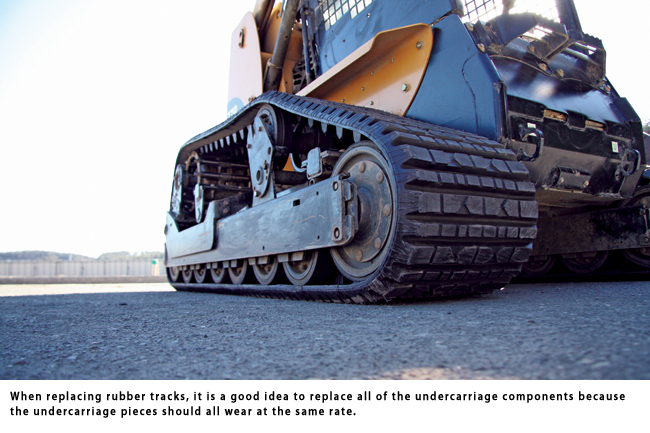Keeping Tracks in Top Shape
Broken rubber track on the jobsite is a problematic situation for contractors. It leads to machine downtime and increased overhead. There are a few cost and time consuming elements to consider when replacing a track beyond just purchasing a new one. More often than not, tracks need to be ordered from out of state or from an unreasonable distance away which leads to more downtime, along with the cost of delivery and labor to replace the track. At the end of the ordeal you could spend around half the price of a track on expenditures. This is why regular maintenance is so important to rubber track’s life span and keeping downtime minimized. Spending a few minutes before and after every use of the machine can significantly lower the cost spent on replacing tracks every year.
There are plenty of ways to provide better care for your rubber tracks and each will add life and performance to your track. Start off by providing proper storage (when a machine is not in use for a reasonable amount of time). Try keeping the tracks out of direct contact to the elements. A common misconception is that because rubber tracks are made of industrial rubber they can withstand sitting in the hot sun or snow and cold for extended amounts of time, but the truth is it reacts like any other rubber would under extended exposure to the elements. It will dry, crack and become brittle if not cared for properly. So try and keep the tracks and machines under a canopy or if that is not possible, just cover the tracks with a tarp when not in operation.

For machines that are in use or on a jobsite, it is important before use of the machine to make sure the tensioning level of the tracks is to specification (usually stated by the owner’s manual). This prevents stretching and ripping when the track is too tight and de-tracking and loss of horsepower when the track is too loose. Something else to try is to clean out the undercarriage of debris with an air gun or a water hose/pressure washer after any major operation. When debris, mud and different compounds gather in the undercarriage, it slowly eats away at the components including the rubber tracks. Rocks will break the rubber from the rollers and expose the metal imbeds inside the track, while the acidic levels in the mud will cause the sprockets and exposed metal imbeds to rust and break apart.
Also when replacing rubber tracks, it is a good idea to replace all of the undercarriage components because
the undercarriage pieces should all wear together. Although it is not noticeable to the naked eye, there is usually a significant amount of wear to other components when the rubber track life has ended. Putting new tracks on old components can cause fitting issues and increase wearing problems. Replacing all the components when changing out the tracks will ensure a smoother, longer life for the tracks and the components. It might cost a little more, but the extra life gained from everything saves money in the long run.
No matter the use of your machine, there are many ways that the tracks and undercarriage can and will be damaged, causing a loss of time and money. But by taking the time to do a little preventive maintenance to your tracks and undercarriage, you can make a drastic difference to the life on your machine. Proper preventive maintenance for rubber tracks might be tedious and seemingly time consuming work, but in the long run will make a difference and be well worth the few extra minutes a day.
Jorel Cuevas works in aftermarket sales and marketing at DRB America, based in Whittier, Calif.

Comments are closed here.